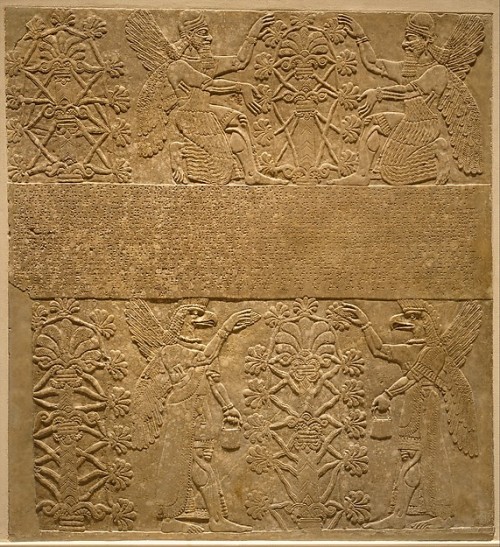Apkallu Details (Excerpt from Wiggermann)
by Estéban Trujillo de Gutiérrez
“Although text II is an extract, and as such less informative on the ritual than text I, it nevertheless supplies information not supplied by text I. The extra information of text II is given below figure by figure in the order of text I.

Human apkallu, known as ummiamu, distinguished with two pairs of wings. In a gesture of ritual purification, he holds a “cleaner” cone in one hand, and a bucket in the other. The cone is called a mullilu, the bucket a banduddu. From Nimrud, capital of king Ashurnarzipal.
AO 19845
For each figure the details relevant to the discussions below are added: number of order in text II, name, number of statues, material, nature, character of incantation and inscription, attributes.
1.1 umu-apkallû, I 44ff.; 7; e’ru; anthropomorphic/human.
attributes: in the right hand: a cornel(-stick) charred at both ends; left hand on breast.
buried: ina SAG g’N?., “at the head of the bed” (II Obv. 11).
incantation: ÉN VII NUN.ME.MEŠ a-šá-red-du-tú, “seven leading sages” (II Obv. 11). Text I omits this incantation; its function is apparently fulfilled by the incantation ÉN UDUG HUL EDIN.NA DAGAL.LA I 40 (cf. below III.C.).
These figures are not supplied with horns of bronze/copper, which would positively identify them as gods, nor do the inscriptions and incantations characterize them as divine: they are sages of human descent, giving life by their incantations, and putting to flight evil.
The lack of added precision in the description (in contrast to the specifications of the bird- and fish-apkallū), and the head dress, garments, and hands, make them anthropomorphic.

A King, Ashurnasirpal, interacts with an attendant at far right. An apkallu is depicted at far left, denoted by his wings and his characteristic pose, with raised right hand and left hand holding a banduddu bucket. Apkallu in this pose typically have a cone in their right hands, a mullilu, which they use to ritually sprinkle water.
[ … ]
9.2 Bird-apkullū, I 170ff.; 7; clay and wax; human/bird.
attributes: in the right hand a cleaner (mullilu), in the left a bucket.
buried: ina SUHUŠ É II-i ina SAG gis NÁ, “at the base of the (wall of the) “second room”, at the head of the bed” (II Obv. 14). The translation of II-i is uncertain: Smith JRAS 1926 696: “second pavement”(709 14: “not clear”); Gurney, Hibbert and Rittig suppose that II-i introduces an alternative position, which seems improbable in the present context.
In MAss/NAss the ša bīti šanî (CAD B 296b) is a servant in the dining room, and bītu šanû is accordingly perhaps “dining room”, cf. CAD B 297f., Kinnier Wilson CTN I 85, Postgate FNALD 5:5, Dailey CTN 3 165 ad 12. An incantation to these figures is attested only in text II (Obv. 14, incipit): ÉN at-tú-nu NU NUN.ME ma-sa-ri, “incantation: you are the statues of the sages, the guardians”: the incipit reveals only a part of their character: they are guardians.

In the top register, Ummiamu, human apkallu that are postdiluvian, tend to a sacred tree. In the lower register, antediluvian apkallu with avian heads tend to a sacred tree.
The tree cones and buckets in their hands are now understood to be standard devices used to sprinkle water, known as mullilu and banduddu, respectively .
The water sprinkling ritual was intended to liberate sin.
10.3 Fish-apkallū, I 174ff.; 7; clay; human/fish.
attributes: in the right hand a cleaner, in the left a bucket.
buried: ina I.DIB. É.NUN, “at the threshold of the bedroom (II Obv. 16)”. The incantation to these figures is the same as the one to the bird-apkallū (only in text II Obv. 16).
11.4 Fish-apkallū, I 178ff.; 7; clay; human/fish.
attributes; in the right hand on offshoot of the datepalm, the left on the breast (Ed Note: sic).
buried: ina tar-si KÁ ina EGIR gil GU.ZA, “opposite the gate, behind the chair” (II Obv. 18)
The incantation to these figures is the same as the one to the bird-apkallū (only in text II Obv. 18).
12.5 Fish-apkallū, I 181ff.; 7; clay; human/fish.
attributes: in the right hand a standard, the left on the breast.
buried: ina MÚRU É ina IGI-[at]gis GU.ZA, “in the middle of the room, in front of the chair” (II Obv. 20).
The incantation to these figures is the same as the one to the bird-apkallū (only in text II Obv. 20.”
F.A.M. Wiggermann, Mesopotamian Protective Spirits: The Ritual Texts, STYX&PP Publications, Groningen, 1992, pp. 46-9.
